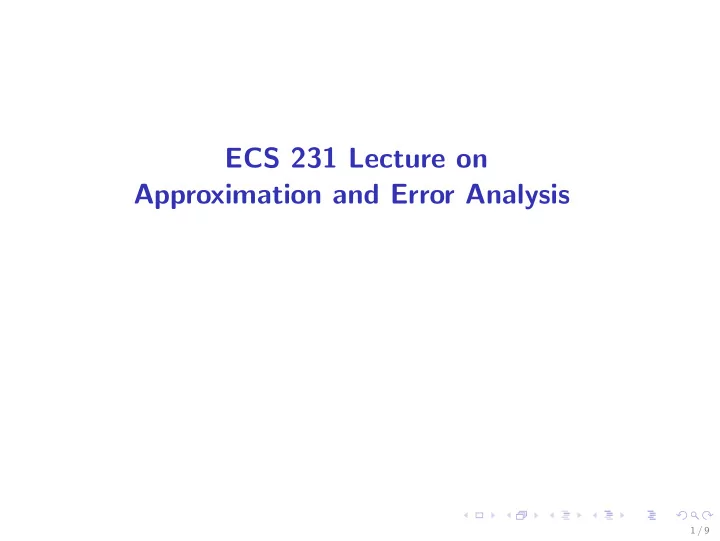

ECS 231 Lecture on Approximation and Error Analysis 1 / 9
Approximation and error analysis 1. Approximation and error ( not mistake! ) are the facts of life. 2. Sources of errors: ◮ measurement and data uncertainty ◮ modeling ◮ truncation (discretization) ◮ rounding in finite precision arithmetic 2 / 9
Approximation and error analysis 3. Consider f : R − → R x − → f ( x ) x , and approximate function � We have an inexact input � f constructued by some algorithm, then f ( x ) − � total error = f ( � x ) x ) − � = [ f ( x ) − f ( � x )] + [ f ( � f ( � x )] = propagated data errors + computational errors � �� � � �� � problem-dependent algorithm-dependent 3 / 9
Approximation and error analysis 4. Error measurements: absolute error and relative error Let � x be an approximation of x . Then the absolute error is defined by abserr ( x ) = | � x − x | , and the relative error (assume that x is a nonzero number) is defined by relerr ( x ) = | ρ | := | � x − x | . | x | 5. Relative error is the proper measure to use since ◮ The relative error is independent of scaling. ◮ � x = x (1 + ρ ) , where | ρ | is the relative error . ◮ Rule of Thumb : if | ρ | = O (10 − d ) , then x and � x agree to about d significant digits, and conversely. 4 / 9
Approximation and error analysis 6. Suppose that an approximation � y to y = f ( x ) is computed. How should we measure the “ quality ” of � y ? Ideally, we would like to have the forward error relerr ( y ) = | y − � y | = “tiny” . | y | However, we don’t know y . Instead, we ask “ for what set of data have we actually solved our problem? ” That is, for what ∆x , do we have y = f ( x + ∆x )? � | ∆x | (or min | ∆x | if there are many such ∆x ) is called backward error . 5 / 9
Approximation and error analysis 7. Two main motivations for using backward error analysis: ◮ interprets errors as being equivalent to perturbations in the data, ◮ reduces the question of bounding or estimating the forward error to perturbation theory, for which many problems is well understood (and only has to be developed once, for the given problem, and not for each method.) 6 / 9
Approximation and error analysis 8. An algorithm for computing y = f ( x ) is called (backward) stable if, for any x , it produces a computed � y with a small backward error, that is, � y = f ( x + ∆x ) for some small ∆x . 7 / 9
Approximation and error analysis 9. The relationship between forward and backward errors for a problem is governed by the conditioning of the problem, that is, the sensitivity of the solution to perturbation in the data. 10. Again, consider y = f ( x ) . Let the computed results in terms of backward error � y = f ( x + ∆x ) . Then the absolute error is � ( ∆x ) 2 � y − y = f ( x + ∆x ) − f ( x ) = f ′ ( x ) ∆x + O � . Correspondingly, the relative error is given by � ∆x � y − y � = x · f ′ ( x ) + O (( ∆ ) 2 ) . y f ( x ) x where � � � � x · f ′ ( x ) � � κ f ( x ) = � � f ( x ) The quantity κ f ( x ) is called the condition number of f at x . κ f ( x ) measures approximately how much the relative backward error in x is magnified by evaluating of f at x . 8 / 9
Approximation and error analysis 11. Rule of Thumb: | relative forward error | ≤ (condition number) ×| relative backward error | 12. The computed solution to an ill-conditioned (i.e., large condition number) problem can have a large forward error, even for small backward error! 9 / 9
Recommend
More recommend